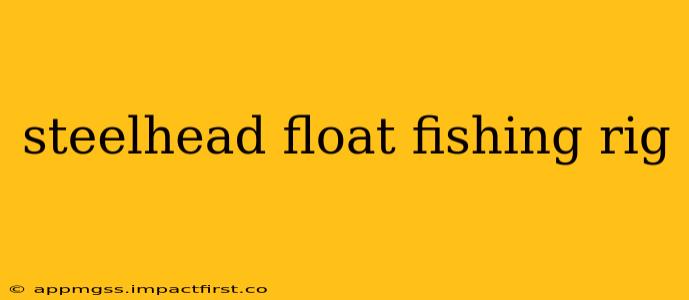Steelhead fishing is a thrilling pursuit, and employing a float fishing rig can significantly enhance your success rate. This technique allows you to present your bait or lure naturally, enticing even the most cautious steelhead. This guide will delve into the intricacies of setting up a successful steelhead float fishing rig, covering various aspects to maximize your chances of landing that prized fish.
What is a Steelhead Float Fishing Rig?
A steelhead float fishing rig is a specialized setup designed for presenting bait or lures at specific depths in rivers and streams. It utilizes a buoyant float to suspend your offering, allowing it to drift naturally with the current, mimicking the movement of a natural food source. This is particularly effective for steelhead, which are known for their cautious feeding habits. The rig typically consists of a float, a leader, a hook, and various weights to control depth and drift.
Choosing the Right Float for Steelhead Fishing
The selection of your float depends on several factors, including river flow, water depth, and the weight of your bait or lure. Larger floats are suitable for faster currents and deeper waters, while smaller floats are more effective in slower, shallower areas. Consider these float types:
- Balsa Floats: Lightweight and sensitive, ideal for detecting subtle bites.
- Styrofoam Floats: Durable and more buoyant, suitable for heavier baits or faster currents.
- Glass Floats: Offer excellent visibility and are quite durable.
How Much Weight Should I Use?
The amount of weight needed to achieve the desired depth and drift is crucial. Too little weight, and your rig will drift too quickly; too much, and your bait will be too heavy and unnatural. Start with a small weight and gradually add more until your float is submerged to the desired level. The goal is to have just enough weight to keep the float slightly submerged, allowing for a natural drift.
What kind of weights are best for steelhead float fishing?
Steelhead float fishing often utilizes split shot weights, which can easily be adjusted along the leader. These small weights allow for precise depth control.
What Kind of Hook Should I Use?
The hook choice depends on your bait or lure. For bait fishing, a size 2-6 hook is generally suitable, while smaller hooks may be necessary for smaller baits. Ensure your hook is sharp and appropriately sized for the size of the steelhead you're targeting.
What type of line is best for steelhead float fishing?
A high-quality monofilament line with a breaking strength appropriate for the size of the steelhead you are targeting is recommended. Braided line can also be used, but it requires more careful management due to its lack of stretch.
How to Tie a Steelhead Float Fishing Rig
There are several ways to tie a steelhead float fishing rig. A simple and effective method is:
- Attach the float stopper to your main line.
- Thread the float onto your line.
- Slide on a second float stopper.
- Tie on a swivel.
- Attach a leader to the swivel.
- Add split shot weights along the leader to control depth.
- Tie your hook to the end of the leader.
What are the best baits for steelhead float fishing?
Effective baits include salmon eggs, worms, and various types of artificial bait.
What are some common mistakes to avoid when float fishing for steelhead?
Common mistakes include using too much weight, using a line that is too heavy or too light, and not paying attention to your float.
How to Set the Hook When Steelhead Bites
When you notice a bite, a slight dip or pause of the float is often a subtle indicator. Don't strike immediately; let the steelhead take the bait fully before setting the hook with a firm, sweeping motion.
Conclusion
Mastering the steelhead float fishing rig requires practice and understanding of river conditions. By carefully selecting your equipment and employing proper techniques, you can significantly increase your chances of success and experience the thrill of landing a magnificent steelhead. Remember to always practice responsible angling techniques and respect the environment.
